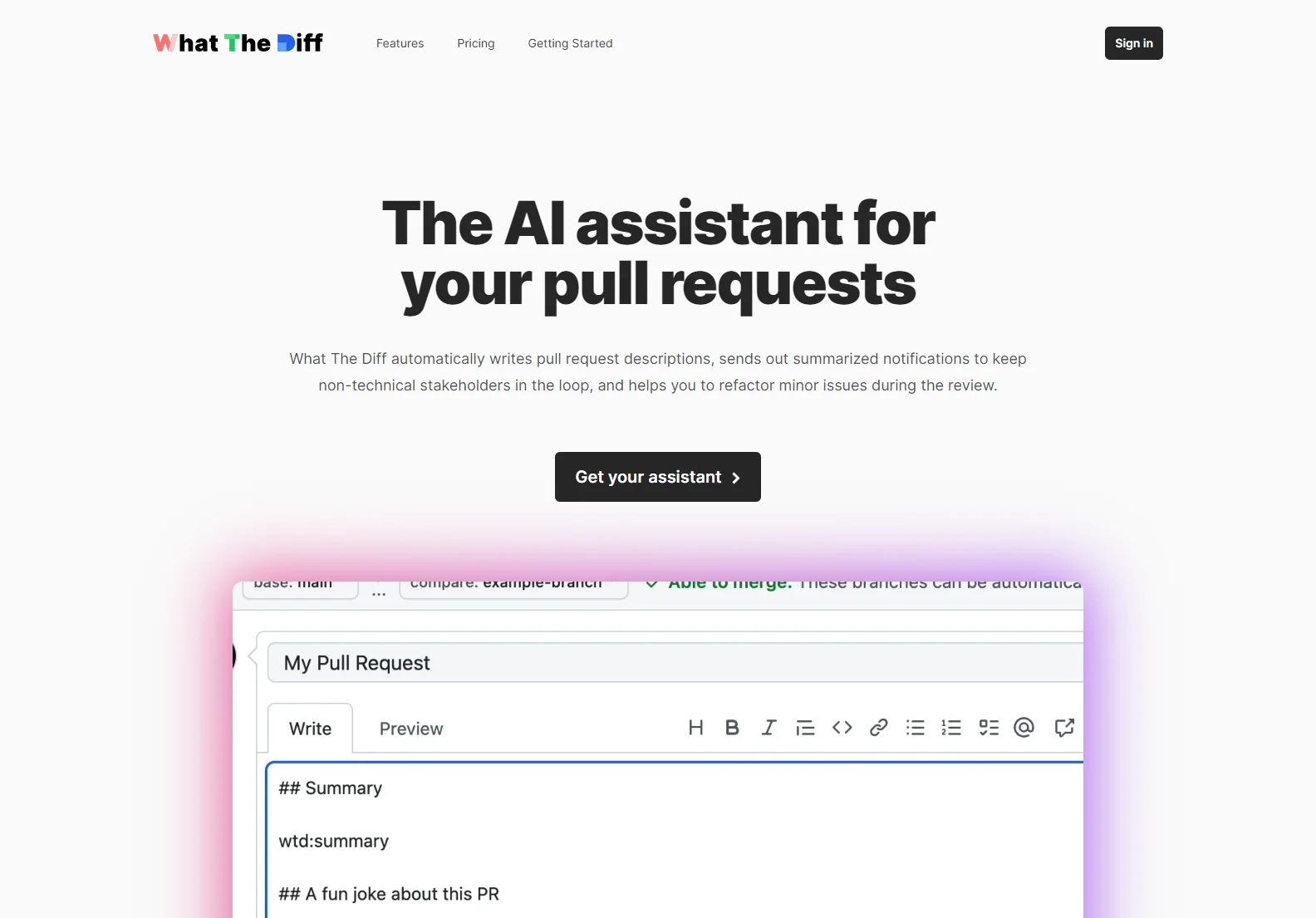What The Diff: Your AI-Powered Pull Request Assistant
What The Diff is an AI-powered tool designed to streamline your code review process. It automates the creation of pull request descriptions, provides concise summaries for non-technical stakeholders, and even assists with minor code refactoring. This significantly reduces the time and effort involved in managing pull requests, making the process more efficient and accessible for everyone involved.
Key Features
- Automated PR Descriptions: What The Diff automatically generates clear and concise descriptions of your code changes, saving you valuable time and effort. It eliminates the tedious task of manually writing descriptions, allowing you to focus on other critical aspects of development.
- Rich Summary Notifications: Keep everyone informed with simplified and translated summaries of pull requests. This ensures that non-technical stakeholders understand the changes without needing in-depth technical knowledge.
- Beautiful Changelogs: Generate professional-looking changelogs that can be shared publicly or accessed via a JSON API for internal use. This provides a clear and organized record of all code changes.
- Weekly Progress Reports: Receive weekly summaries of all changes, providing a high-level overview of your team's progress and accomplishments.
- Inline AI Refactoring: What The Diff offers AI-powered code refactoring suggestions directly within the pull request, improving code quality and reducing the need for extensive manual review.
- Fine-grained Settings: Customize your experience with granular settings, allowing you to skip CI pull requests, delay draft ones, and manage your token consumption efficiently.
Pricing
What The Diff offers various pricing plans to suit different needs and budgets. Details on specific plans and pricing are available on their website. (Note: Pricing details are omitted here as they are subject to change and should be obtained directly from the provider.)
Comparisons
Compared to other code review tools, What The Diff stands out with its AI-powered automation and focus on accessibility for non-technical users. While other tools may offer some automated features, What The Diff provides a more comprehensive suite of AI-driven capabilities, making it a more efficient and user-friendly solution.
Getting Started
Getting started with What The Diff is simple. Connect your GitHub or GitLab account to create an account and begin using the tool's features. The platform provides a user-friendly interface and comprehensive documentation to guide you through the process.
Frequently Asked Questions
- What is What-the-Diff?: What-the-Diff is an AI-powered application that analyzes the diff of your pull requests and generates descriptive comments in plain English (and other supported languages).
- What are tokens?: Tokens represent the processing power needed to analyze pull request diffs. Larger diffs require more tokens.
- How does What the Diff work?: It uses the GitHub/GitLab API to access pull request diffs and employs an AI model to generate descriptions. Your code is not stored.
- Does it support all languages?: Yes, it supports most programming languages and provides descriptions in multiple languages.
- What happens if I run out of tokens?: You can upgrade your plan or wait until your next billing cycle. Automatic upgrades are not available.
- Do you store my code?: No, your code is not stored by What The Diff or its third-party services.
- Do unused tokens roll over?: No, unused tokens do not carry over to the next month.
- Do you train your AI model with my code?: No, your code is not used to train the AI model.
- Why do you need full access to my code?: Unfortunately, GitHub/GitLab APIs require full access to read the diff of a pull request. What The Diff does not store your code.
Conclusion
What The Diff offers a powerful and efficient solution for managing pull requests. Its AI-powered features simplify the process, improve collaboration, and make code reviews more accessible to everyone. The tool's ease of use, comprehensive features, and focus on user privacy make it a valuable asset for any development team.

